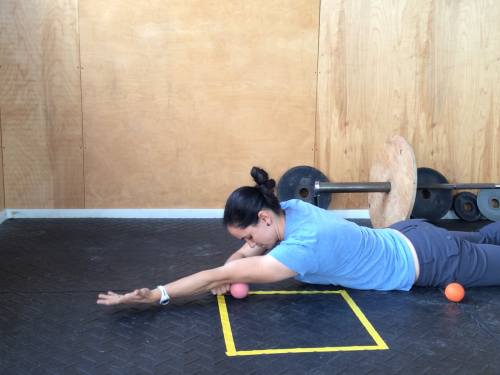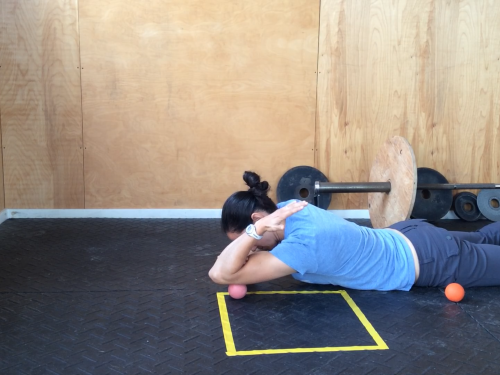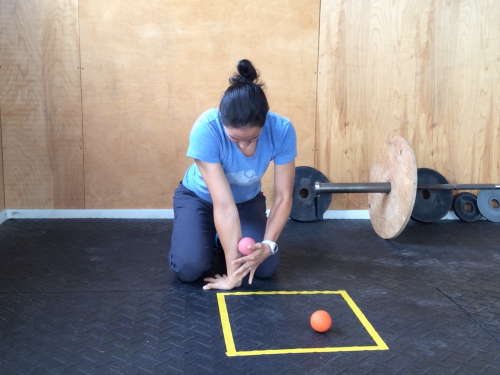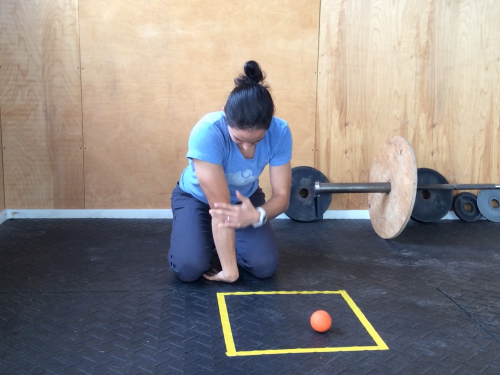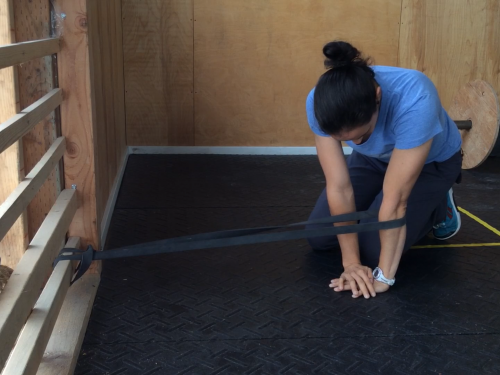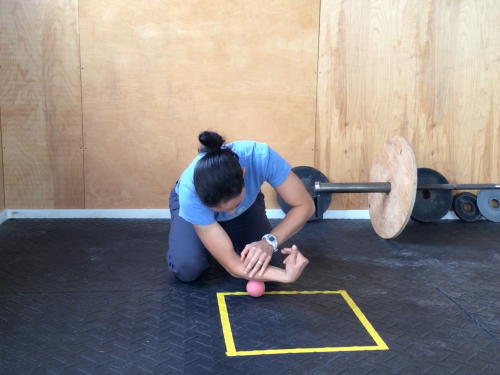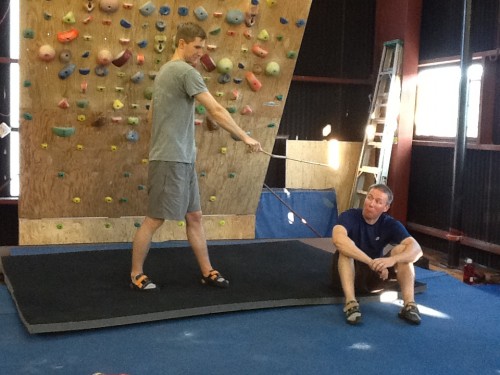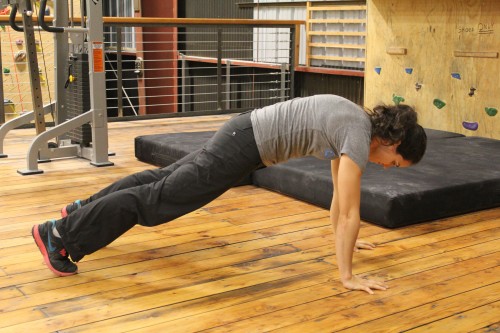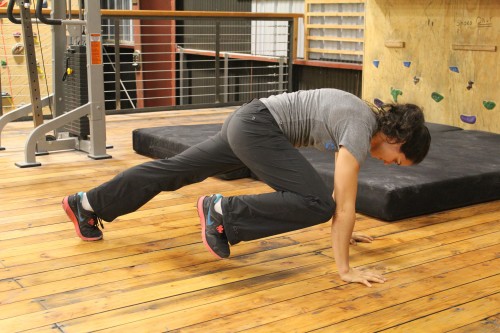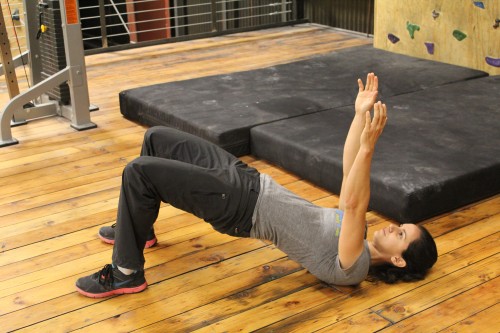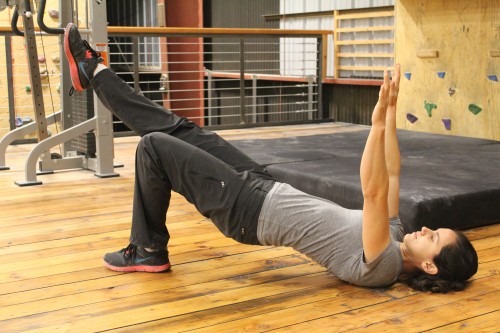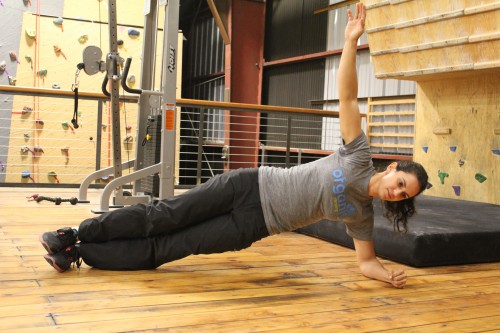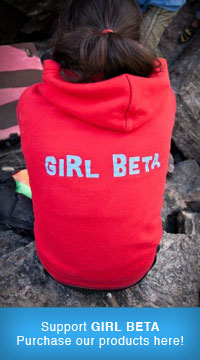Archive for the ‘Articles’ Category
Quick Fixes for your Wrists and Elbows
Often as desk bound climbers, we get nagging pain in our wrists and elbows. Most of the time we attribute it to overuse, which in some cases could be accurate, but in others, it may simply be a shortening of the muscles due to everyday use. This can easily be managed by some stretching and myo-fascial release or also known as ‘smashing’. Smashing unglues short and stiff muscles, restoring them to their proper length. This may take several attempts, but if you are diligent each day to smash away and stretch, your elbows and wrists will gain back their full range of motion.
ELBOWS
Location of lacrosse ball: base of the elbow, at the tricep.
Movement: extend and flex the arm, so that the lacrosse ball smashes into the base of the tricep.
Duration: 30 sec – 2 mins
Location of lacrosse ball: posterior forearm/anterior forearm
Movement: apply constant pressure as you roll up and down the forearm, you will notice that I have put my forearm into a stretched position.
Duration: 30 sec – 2 mins
Location of resistance band: below the elbow
Movement: make sure the fingers are facing in the same direction as the band, bend the elbow, and slowly release into extension. Repeat until you feel a change in the joint.
Duration: 30 sec – 2mins
WRIST/FOREARM
Location of lacrosse ball: 2 lacrosse balls, one underneath, and one in your hand.
Movement: apply pressure at both points, move your wrist into flexion and extension. Repeat along several points in your forearm.
Duration: 30 sec – 2 mins
The resource I used was “Becoming a Supple Leopard” by Kelly Starrett.
Do Climber’s Need Aerobic Training? Part 2
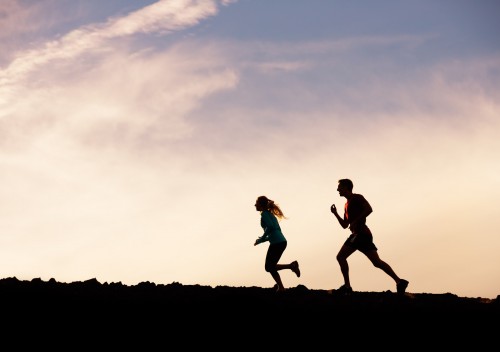 Last month I talked about the benefits of aerobic training, how it increases your capacity to do more work, recovers muscles from hard training days, and it can teach you how to regulate your breathing and heart rate while climbing. Because we are rock climbers, and not training to be a runner, the program will be different. The recommendations listed will be primarily for recovery from climbing or other strength related training.
Last month I talked about the benefits of aerobic training, how it increases your capacity to do more work, recovers muscles from hard training days, and it can teach you how to regulate your breathing and heart rate while climbing. Because we are rock climbers, and not training to be a runner, the program will be different. The recommendations listed will be primarily for recovery from climbing or other strength related training.
So how do you start adding in aerobic training into your lifestyle? If you are anything like me, I hated running because I felt I was constantly in pain when I ran, mostly because I tried to beat or maintain my last running pace. Silly Mercedes. But what I discovered was that I didn’t need to run at a high intensity every time I ran. I started running at an intensity that was slow and long, keeping my breathing constant, smooth and unlabored. You may have heard this term before “Long-Slow Distance”, where essentially you can have a conversation while you run. This is the type of running you will do for recovery adaptations. Don’t feel like you need to go fast at all, and if you do, you won’t get the recovery benefits from the this type of training
I’ve been doing this program myself for a few weeks now and have been able to increase my speed and distance while keeping my heart rate low. This is the kind of adaptation you want to start with. Add one run (or aerobic activity) a week at very low intensity (easy breathing, low heart rate around 75%-80% of your Max Heart Rate) keeping it easy and long (between 30-60 minutes). Then you can add in another aerobic session if you have the time. Make sure to add aerobic training in at the end of a climbing session or after a strength training session. If you can’t do it afterwards, try to separate the aerobic training from your climbing or strength training by a few hours.
Of course, there is much more you can do with your aerobic training, and if you are getting amped about it, you can integrate one day of high intensity running intervals to train the other side of the intensity spectrum. But this type of training does not help recovery from training, rather it actually taxes the muscles more and is used to improve adaptations specific to strength and power, which is also beneficial for a rock climber.
Email me at info@girlbeta.com if you have any questions or need some help on how to design an aerobic program for yourself.
- Mercedes Pollmeier, MS, CSCS
Do Climber’s Need Aerobic Training? Part 1
Do you ever find yourself climbing up a route and you reach the crux, you make a few difficult moves and you start to huff and puff, and ultimately your heavy breathing leaves you falling off the route? Do you find yourself huffing and puffing on the approach to your climb, and feel a bit taxed before you even start climbing? Those who climb mountains already know the importance of cardio and how it’s a major part of their training, however, for a rock climber, cardio is often forgotten.
There are several benefits for rock climbers to do aerobic training; it can increase work capacity, shorten recovery time between training sessions, teach you how to regulate your breathing, and control heart rate during training.
Just like strength training, cardio done right will increase your capacity to do more work, which means being able to do more difficult moves over a longer period of time. Aerobic training increases the working capacity of the muscles by providing quick and sufficient energy to allow the muscles to contract over and over again. There are several adaptations that occur in the muscle from aerobic training, all which increases performance for a rock climber.
Low intensity running after climbing can increase recovery from a tough session. Running for about 30+ minutes will consistently pump blood to muscles and tendons, repairing tissue damage as well as decreasing soreness.
Aerobic training also teaches you how to breathe rhythmically, and to control your heart rate and breathing rate during spikes in intensity, especially if you train with a heart rate monitor. However, this type of training needs to be intentional and done on a regular basis.
And finally, humans were first and foremost an endurance based species, hunting for food and constantly moving from one location to the next, so tapping into what is genetically engrained will undoubtedly unlock athletic potential.
Next month, I will show you what kind of running to add into your week and when to do it.
Recovery tips: how to optimize your recovery before your next climbing session
If you are one who is training a ton this winter as well as trying to ski or enjoy winter sports on the weekends, you probably aren’t giving enough attention to your recovery. The more efficient you recover, the sooner you are ready for the next hard workout, as well as avoiding plateaus and burn out.As an active person, if you don’t recover adequately, you will more than likely weaken your immune system, as well as underperform and feel fatigued. The reason for this is when we exercise and then add in stressors of life and work, without recovering properly, our ‘sympathetic nervous system’ takes over, which is our fight or flight response. This system accelerates heart rate, disrupts sleeping patterns, reduces metabolism, increases carbohydrate cravings etc. If this system takes over for too long, you could potentially ‘hit the wall.’
A good place to start the process of recovery is right after your workout or climbing session. Supplementing with a protein drink, either a carb + protein blend, or a BCAA’s drink, within 15 minutes of finishing your workout, will kick start your recovery. Eating unprocessed/natural food, within one hour of your workout is also essential in your recovery. Doing these two initial steps can stimulate growth hormone and testosterone in your body to activate recovery, and help repair your muscles efficiently. Next, you want to focus on activities that decrease the activity of the ‘sympathetic nervous system’ and increase ‘parasympathetic nervous system’, your rest and recovery response. Things like foam rolling, stretching, yoga, meditation, and massage all stimulate this response. These will improve circulation and blood flow, so that wastes are taken out of the body while being replaced with new nutrients. Aim for about 30 minutes a day of intentional recovery.
Some other recommendations would be to sleep around 8 hours a night, drink plenty of water, vary your training intensity and try cross training, avoid using anti-inflammatories, and be sure to eat as many nutrient dense foods, and avoid processed foods. All of these things can help reduce your stress, help you get ready for your next workout, and lower your risk of getting sick this spring!
From Squamish to Guanella Pass in my Vapor V’s
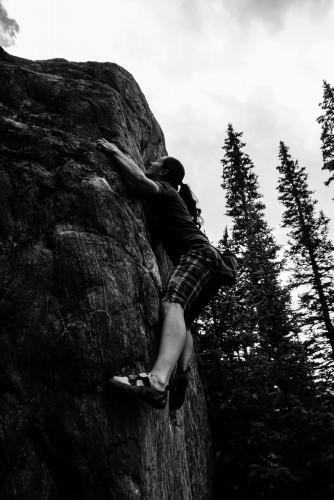 I have been living in Seattle for a year now, 1 YEAR! I have somehow managed to survive my first winter here in Seattle, but it wouldn’t have been possible without being able to climb in Squamish and Leavenworth. Now, if you know these areas, you know that the rock just doesn’t give you any feet to work with, and for full value of boulder problems, you will have to beach whale your way over the top outs. This has been a new learning experience for me. These areas have taught me to use my feet, and be creative. During this time, I switched from the Scarpa’s Vapor S climbing shoe to the Vapor V’s, in hopes that with its design of being a little less aggressive, it will help me feel the rock more. And they did. I learned to feel the rock and trust the rubber that these shoes have to offer. My foot work improved and it was tested when I went back to Colorado for a day in Guanella Pass. When I walked up to the boulders, I looked at the problems and yelled “there are foot holds!!” “Yay!” I only took my Vapor V climbing shoes, because I am just so used to that, and was able to edge on all of the holds, everywhere on the rock. I was able to climb so many boulder problems, and my feet felt so comfortable and solid. I even got to send a ridiculous project from about 3 years ago, Ninja Pony Ride, with hardly any issues. It has a precise heel hook hand match, then a powerful reach across to a sloper. With the ridges on the heel cup, I was able to stick this thing and it felt awesome. Now I’m back in Seattle, ready to go climb in Squamish and Leavenworth again. I love my climbing shoes so much, that in my passion, so many of my clients at Vertical World have purchased them and have had great results. If you are interested in buying a pair of your own, check out The Clymb where they offer Vapor V’s and a ton of other awesome climbing gear to help you send.
I have been living in Seattle for a year now, 1 YEAR! I have somehow managed to survive my first winter here in Seattle, but it wouldn’t have been possible without being able to climb in Squamish and Leavenworth. Now, if you know these areas, you know that the rock just doesn’t give you any feet to work with, and for full value of boulder problems, you will have to beach whale your way over the top outs. This has been a new learning experience for me. These areas have taught me to use my feet, and be creative. During this time, I switched from the Scarpa’s Vapor S climbing shoe to the Vapor V’s, in hopes that with its design of being a little less aggressive, it will help me feel the rock more. And they did. I learned to feel the rock and trust the rubber that these shoes have to offer. My foot work improved and it was tested when I went back to Colorado for a day in Guanella Pass. When I walked up to the boulders, I looked at the problems and yelled “there are foot holds!!” “Yay!” I only took my Vapor V climbing shoes, because I am just so used to that, and was able to edge on all of the holds, everywhere on the rock. I was able to climb so many boulder problems, and my feet felt so comfortable and solid. I even got to send a ridiculous project from about 3 years ago, Ninja Pony Ride, with hardly any issues. It has a precise heel hook hand match, then a powerful reach across to a sloper. With the ridges on the heel cup, I was able to stick this thing and it felt awesome. Now I’m back in Seattle, ready to go climb in Squamish and Leavenworth again. I love my climbing shoes so much, that in my passion, so many of my clients at Vertical World have purchased them and have had great results. If you are interested in buying a pair of your own, check out The Clymb where they offer Vapor V’s and a ton of other awesome climbing gear to help you send.
Evan and Ian getting some motivation during the System’s Wall class at Vertical World
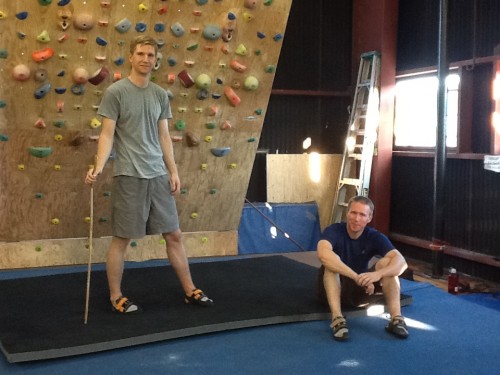
Sport Climbing and Aid Climbing Training
Here are a few follow along training videos for Sport Climbing and Aid Climbing. These were made for Climbing Magazine’s Edition of the 50 Classic Climbs. Check out my full article in Climbing Magazine here!.
Climbing Specific Strength Training from Mercedes Pollmeier on Vimeo.
Aid climbing from Mercedes Pollmeier on Vimeo.
What Nutrition Category do you fall into?
Are you Paleo? Are you Vegan? Are you Gluten Free? Well, it is so hard to say what kind of nutrition category I fall into. I’m not entirely Paleo, I’m not entirely gluten free, I’m not entirely against all carbs. I know for sure that once I do fixate on one category and am completely strict about my diet, I tend to freak out a few weeks in and totally lose it. I end up having a worse diet than I did before.
I am bringing this up because recently I read a few articles by Dr. John Berardi. He is hands down one of the best nutritionists today and all of his work is research based but also very practical. He has worked with thousands of people, elite athletes, recreational athletes, people looking to be healthier, the obese population, etc. He knows his stuff and can formulate a plan for anyone. He himself said that he can’t quite fit into a specific category when it comes to nutrition. He says that people are too different from one another and that you just cannot recommend the same diet for everyone. We all have different body types, come from different areas around the world, and have different genetic needs. Exercise, and the type of exercise, also plays a big part in what you eat and what you need nutritionally.
One of the best things that come out of dieting is that you become more aware of what you put into your mouth. What you shove into your mouth ultimately has an affect on your current body and your future body. I know that if I eat more sweets, the next day my joints hurt. This is a deduction I have finally made because of cleaning up my diet. Now, that’s not to say that I will stop eating sweets, but I am aware of it and do my best to keep the sweets to a minimum. I know that if I eat a small breakfast, I tend to be so darn hungry in the afternoon, I will eat and eat until I am stuffed, and sometimes choosing the wrong foods to fill my appetite. I have learned this through adjusting my portion sizes and the timing of my meals.
In the past I have been so reluctant to advise people on dieting, because the field of nutrition is so complex and there is not one cure all method of dieting. But what I can advise is to try things out, and take small steps to changing how you eat, because in the end, you want to change your behavior of eating, not just what you eat. So, taking it slowly will ensure your retention to change, and you wont stress out and explode. You will have, as I like to call it, “fat” days where you cheat here and there, because you socialize, go out to eat, holidays etc, but in all, you do your best in changing how you eat. For me it was the timing of my meals (trying not to eat after 6pm, eating high protein foods after workouts), eating whole foods (reducing the amount of processed foods), and eating smaller, more frequent meals (every 2-3 hours).
If you’d like more information on how to get started on a better eating regime, you should check out Dr. Berardi’s site. He offers a free 5 day course that will actually help you get started in the right direction. He breaks everything down and always gives research based info so that you can learn and know what he knows.
Here are the links to the Free 5 day courses. It’s different for men and women, so make sure you click on the right one ![]()
Free Video Course on Fat Loss for Men
www.precisionnutrition.com/cmd.php?pageid=1539074&u=m
Free Video Course on Fat Loss for Women
Post Workout Nutrition
The other day, after running an intense climbing workout class, one of my clients asked me what the best post workout foods or
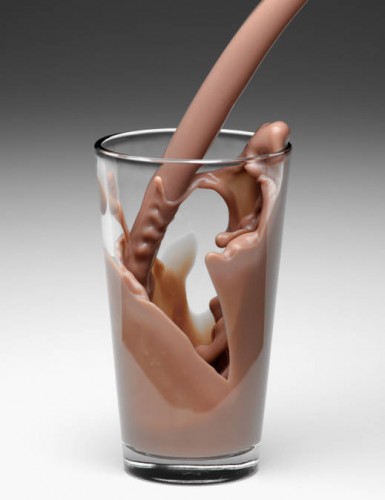 supplements are to take for recovery. My answer was Chocolate Milk! This is because it has the optimal ratio of carbohydrates to complete proteins (whey and casein).
supplements are to take for recovery. My answer was Chocolate Milk! This is because it has the optimal ratio of carbohydrates to complete proteins (whey and casein).
When it comes to recovery, it’s all about eating the right ratio of carbohydrates and protein within a 30 minute period after your workout.
This is when your body is sensitive to insulin. By eating the right ratio (4:1) of carbs to protein, the better your muscles can synthesize protein, replenish muscle glycogen, reduce muscle soreness, and improve muscular strength and body composition.
According to scientific research1, whey protein and casein are two of the best complete proteins to ingest after workouts. Whey protein is fast acting and increases protein synthesis, whereas casein is slow acting and inhibits protein breakdown, both very useful mechanisms for recovery after intense exercise. Whey and casein come from milk, and can be found in other dairy products. If you are lactose intolerant, manufacturers make whey protein isolate, which is lactose free, and can often include casein.
If you prefer not to consume animal products, one of several supplements that is closest to a complete protein is Hemp protein. Your goal is to have a fast acting supplement or food after your workouts.
- Mercedes Pollmeier
Below are some other examples of the preferred ratio of carbohydrate to protein:
| Food Item | Carbohydrates (grams) | Protein (grams) |
| Non-fat chocolate milk, 8oz | 26 | 8 |
| Non-fat, fruit on the bottom yogurt, 6 oz | 28 | 6 |
| 1 mozzarella string cheese stick, 5 whole grain crackers, 10 grapes | 26 | 8.5 |
| 1 cup Cheerios® and 1/2 cup of milk | 27 | 7 |
| 1/4 cup of hummus and 1/2 cup of carrots | 15 | 5 |
| 1 slice of whole-grain bread, 1 oz turkey with mustard, and 1 cup of apple juice | 35 | 9 |
______________________________
1. Wein, D & Miraglia, M. Whey Protein vs. Casein Protein and Optimal Recovery. NSCA Performance Training Journal . 2013.
Core Strength Training
by Mercedes Pollmeier, M.S., CSCS
First of all, what is the core? Well, it’s definitely not just your abs. It incorporates most of your trunk, your back and your butt. Some exercise science specialists also say that the core can extend all the way down your hamstrings (posterior chain) and quadriceps (anterior chain). The core really is the ability to recruit as many muscles as possible to make movement as efficient as possible. By doing this, you decrease your chance of injury as well as making your body more balanced. This is why it is very important to do “core” training, or also known as full body exercises.
In climbing, when you cut your feet from the wall, what is the deciding factor to stay on the wall? Well, it’s actually a number of factors, and all are included in the “core”. In order to bring your feet back to the wall, you must have the finger strength, shoulder strength, trunk strength, lat strength and back strength to swing back on and accurately place your foot. This means training all of these things together to achieve awesomeness.
What exercises would be good for core development? Well, first of all, I believe that women in general have really good isolated ab strength. When we do crunches compared to our male counterparts, it seems we can go forever. But, when you ask us to do more integrated exercises, such as leg lifts from a bar, we fall apart. So ladies, work less on isolated ab exercises and more on integrated exercises.
My recommendations:
If you have never done ab exercises before, or have had some time off from training, or if you have a lower body injury that you are recovering from, you should start with gradual isolated ab exercises that work on the transverse abdominis and spinal muscles. This is very important to do!
Once you have done this for a few weeks, you can progress to some more difficult exercises that involve leg lifts, leg lifts with medicine balls, hanging knee raises etc.
Exercises that create a lot of tension or torque are also very important to incorporate into your regime. This is where all the muscles communicate with each other at the same time. Good examples are the front elbow plank, side elbow plank, and other really awesome varieties of the plank. To get the posterior chain, you can do hip bridges and table tops.
Climbing specific “core” exercises would be anything that involves hanging. Toe touches to the bar, front lever variations, windshield wipers are good examples of these.
Don’t forget! Squats, dead lifts, push ups and pull ups are also considered “core” exercises, because they involve the whole body to achieve the movement. Be safe with your exercises, take the progressions slow, and don’t push yourself to fast to achieve results. Your goal is to stay injury free as you become as strong as an OX.
For more training advice or online coaching contact info@girlbeta.com
“On the Wall”
Here is a video about Erin Machinchick, who is a fairly new climber and offers a great perspective on what it’s like when you make climbing a part of your life. She has only been climbing for a year now and has already lead a 5.12a outside. Keep it up Erin!
“On the Wall” – A Rock Climbing Story from 5 Mile Films on Vimeo.
You are currently browsing the archives for the Articles category.
Analytics Plugin made by VLC Media Player

